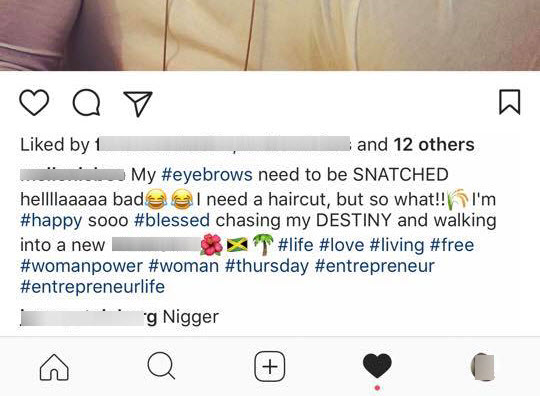 As a person who uses social media to increase awareness of my brand, I find the actions that have been taken against one female blogger to be truly disturbing.
As a person who uses social media to increase awareness of my brand, I find the actions that have been taken against one female blogger to be truly disturbing.
On my blog, I don’t expect everyone to agree with my views and opinions and that’s the price I pay for being visible. However, disagreements become disgusting when it involves death and rape threats and pictures that are meant to demean, silence and put fear in someone’s mind.
This has happened to a blogger by the name of Kathy Sierra who blogs over at Creating Passionate Users. Four weeks ago, she started getting death threats in her inbox. While scary, she didn’t think anything of it until someone started posting pictures of her with a noose around her neck and being muzzled with a thong.
This prompted Sierra to cancel a speech she was supposed to give due to these awful pictures and comments. She is now seeing a psychiatrist, is taking tranquilizers and won’t leave her home. This story has made it to the BBC and is being blogged about by many bloggers. The police are also involved.
In particular, she raises a key point about the lack of women at tech conferences, saying:
“Of course, Frank and Jeneane are among the people who make outraged posts about the lack of female speakers at tech conferences. If THIS is what a woman has to put up with for having visibility in the tech world…”
I have worked in a male dominated field for 13-years. I have seen my share of sexism, even racism at the hands of male co-workers. While any type of ism will rear its ugly head in the workplace, it’s the response of those around you that will be the catalyst as to whether that behaviour is tolerated or nipped in the bud.
Also, because the harasser has a face, it’s easier to know who to direct your attention to. In this case, the person who sent Kathy the emails and posted those vile photos on the web is unknown. She can only guess who it is based on who the blog belongs to, but at the end of the day, she’s not even sure who to direct her anger towards.
This is troubling and would explain why Kathy has taken such drastic measures not to be seen or heard. In essence, she has chosen to be invisibile until the police complete their investigation. Even then, who knows whether or not Kathy will feel comfortable enough to be visible through her blog and presentations.
This is sad, not only because Kathy is such a prominent and prolific person in the technology field, but also because those who choose to bully online do so behind the veil of anonymity. As Seth Godin says on his blog:
“Anonymity hasn’t made the web a better place. Instead, it has allowed some of the worst ideas ever to get published.”
The case here is to protect the visibility and openess of social media by discouraging anonymity. This will be difficult because this rests on the person creating the content being honest and forthright about the information they’re inputting online.
It’s too bad that there isn’t a certification process that people need to go through before creating profiles online. There should be a Social Media Certification process that everyone should be required to go through before submitting a profile on YouTube, MySpace or Bloglines. There should be questions such as:
- Where you a bully in school?
- If someone sent you an email critiquing what you wore that morning, would you flame back, ignore it or respond politely?
- Were you honest on your tax return last year?
- Do you like yourself?
- How many people in your life trust you?
Answers would be weighted and scored. If the score is high enough, then the person can proceed because they would’ve been Social Media Certified.
Now, I suggest this, not to make light of Kathy’s situation, but to show that it would indeed be difficult to eliminate anonymity. No matter what safeguards are put in place, there will always be those who will never follow the rules and will use the Internet to fuel fantasies that they can’t easily act out in reality (notice, I didn’t say never otherwise the police wouldn’t be taking this seriously).
Despite this, there are some things we can do in blogosphere and podosphere to discourge those who choose to hide behind the name Anonymous:
- Moderate all comments.
- Insist that people identify themselves on your blog.
- Delete any anonymous comments from your blog.
- Blog or podcast supporting Kathy.
- Encourage Kathy not to let these scums silence her.
- Don’t use Twitter (okay, I threw that one in there).
- If you find a racist, sexist, hurtful comment, tell the commenter that it’s not okay (from Tara’s blog).
What else?
Update: Tara Hunt posted her thoughts about this saying that we need to start telling people in blogosphere that attacks like this are not okay. I especially like this quote that she made on her blog:
“We cannot tolerate these attacks any longer. Sites like DIGG and Slashdot and instant chatrooms on sites are filled with awful dialogue. Sexist, racist, hateful stuff. Stuff that, I’m sure, these people wouldn’t dream of saying if their identities were revealed.”
Tags: ![]() kathy sierra,
kathy sierra, ![]() social media,
social media, ![]() podcasting,
podcasting, ![]() blogging,
blogging, ![]() technology,
technology, ![]() women,
women, ![]() women in technology,
women in technology, ![]() visible,
visible, ![]() seth godin,
seth godin, ![]() tara hunt
tara hunt


0 Comments
Trackbacks/Pingbacks